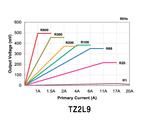picgak
Advanced Member level 1

- Joined
- Oct 13, 2011
- Messages
- 407
- Helped
- 102
- Reputation
- 204
- Reaction score
- 102
- Trophy points
- 1,323
- Activity points
- 3,177
jagdeep
For 2000VA you will be drawing almost 42 amps from a 48v battery. you can use IRF250 instead of IRL3803 in circuit. TR1 should be 44vAc/230vAc. I think Mr.Taners circuit is for 500VA. If it is so the secondary turns for the CT should be reduced dividing the current turn Nos by 4 for 2000VA. The resistors R28 and R29 may be increased to 10k. Since TLP250 rating is only upto 35v a regulated power supply 15v may be used. The points marked U+ should be 12vdc only. 48v is applied only to the upper half of the H bridge mosfets drain point instead of U+. I think this will solve your problem.
regards
ani
For 2000VA you will be drawing almost 42 amps from a 48v battery. you can use IRF250 instead of IRL3803 in circuit. TR1 should be 44vAc/230vAc. I think Mr.Taners circuit is for 500VA. If it is so the secondary turns for the CT should be reduced dividing the current turn Nos by 4 for 2000VA. The resistors R28 and R29 may be increased to 10k. Since TLP250 rating is only upto 35v a regulated power supply 15v may be used. The points marked U+ should be 12vdc only. 48v is applied only to the upper half of the H bridge mosfets drain point instead of U+. I think this will solve your problem.
regards
ani







